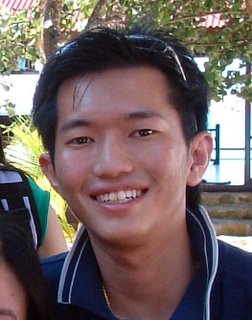Dive #3: Southern Tip, Lima
Date: 25 August 2006
Day: Friday
Time: 14:46 (GMT +8:00)
Location: Redang Island Malaysia
Duration: 0:43
Cumulative Time: 2:12
Max Depth: 13.4 meters
Sky: Clear
Waters: Slightly Choppy
Visibility: 6-7 meters
Bottom Temp: 30 ºC
Starting Air: 3,000psi
Ending Air: 750psi
Surface Interval: 3:08
Starting Pressure Group: A
Ending Pressure Group: O
Dive Buddy: Soon Yean
Divemaster: John Oh (Coral Redang)
My first boat dive. It was a short 10 minute boat ride from Pasir Panjang to Southern Tip of Lima. Lima being the name because of the cluster of 5 small islands in the area, clearly visible from Pasir Panjang.
Water entry style was the giant stride, basically standing upright at the edge of the boat and taking a huge step forward, dropping legs-first into the water. It was slightly awkward because while some used the back edge of the boat, my closest exit was the side. I clumsily stepped up onto the edge with my fins on. I had to keep my body slightly bent forward to avoid having my head or tank bump against the ceiling as I move forward.
Concentrating on making sure I don't snag my gear on any part of the boat, while trying my best to maintain balance, I forgot my training on the actual giant stride. The drop from the boat was natural, but the screw-up was in the positioning of my hands. One hand should have been flat against my face to prevent the mask and regulator from coming out, while the other hand should have been on my weight belt to avoid accidental release upon water entry. Instead I was so focused on clinging to the rails to balance myself.
It's a good thing I didn't lose any gear upon entry. Having the mask and regulator come off would mean that I'd end up breathing water instead of air, a definite bad! And if the weight belt accidentally released itself, it would have sank straight to the bottom and I'd have no way of descending. I've seen it happen to one of my classmates during a pool session and I sure as hell wouldn't want it to happen to me.
We got to do a bit of navigation swimming with a compass, both at the surface and below. Can't say I really caught it, but I guess I'll get better as I progress to become an Advanced Open Water Diver.
This dive was deeper, and aquatic life abundant. Apart from the usual encounters, we also had a green turtle swimming around down there. Size was about 2.5 feet or so. I'm still not very good at judging size, length, distance & depth yet. Everything below the surface seems so distorted. But trust me, it doesn't spoil the experience one bit!
Day: Friday
Time: 14:46 (GMT +8:00)
Location: Redang Island Malaysia
Duration: 0:43
Cumulative Time: 2:12
Max Depth: 13.4 meters
Sky: Clear
Waters: Slightly Choppy
Visibility: 6-7 meters
Bottom Temp: 30 ºC
Starting Air: 3,000psi
Ending Air: 750psi
Surface Interval: 3:08
Starting Pressure Group: A
Ending Pressure Group: O
Dive Buddy: Soon Yean
Divemaster: John Oh (Coral Redang)
My first boat dive. It was a short 10 minute boat ride from Pasir Panjang to Southern Tip of Lima. Lima being the name because of the cluster of 5 small islands in the area, clearly visible from Pasir Panjang.
Water entry style was the giant stride, basically standing upright at the edge of the boat and taking a huge step forward, dropping legs-first into the water. It was slightly awkward because while some used the back edge of the boat, my closest exit was the side. I clumsily stepped up onto the edge with my fins on. I had to keep my body slightly bent forward to avoid having my head or tank bump against the ceiling as I move forward.
Concentrating on making sure I don't snag my gear on any part of the boat, while trying my best to maintain balance, I forgot my training on the actual giant stride. The drop from the boat was natural, but the screw-up was in the positioning of my hands. One hand should have been flat against my face to prevent the mask and regulator from coming out, while the other hand should have been on my weight belt to avoid accidental release upon water entry. Instead I was so focused on clinging to the rails to balance myself.
It's a good thing I didn't lose any gear upon entry. Having the mask and regulator come off would mean that I'd end up breathing water instead of air, a definite bad! And if the weight belt accidentally released itself, it would have sank straight to the bottom and I'd have no way of descending. I've seen it happen to one of my classmates during a pool session and I sure as hell wouldn't want it to happen to me.
We got to do a bit of navigation swimming with a compass, both at the surface and below. Can't say I really caught it, but I guess I'll get better as I progress to become an Advanced Open Water Diver.
This dive was deeper, and aquatic life abundant. Apart from the usual encounters, we also had a green turtle swimming around down there. Size was about 2.5 feet or so. I'm still not very good at judging size, length, distance & depth yet. Everything below the surface seems so distorted. But trust me, it doesn't spoil the experience one bit!

